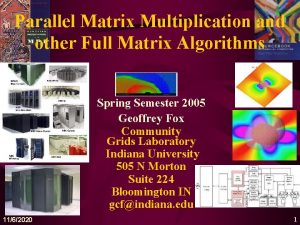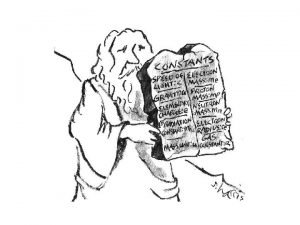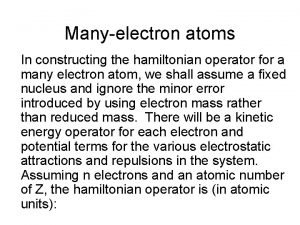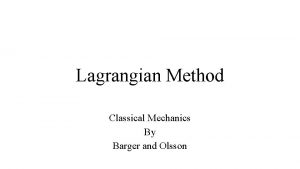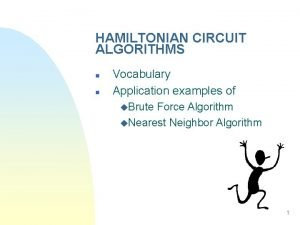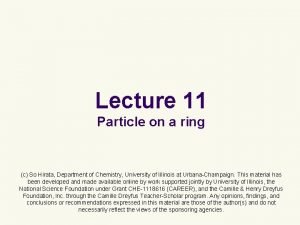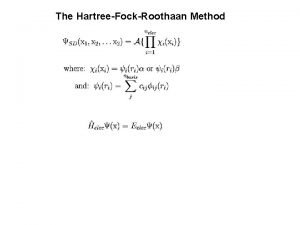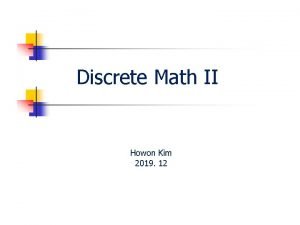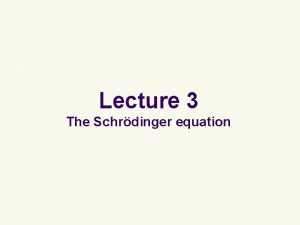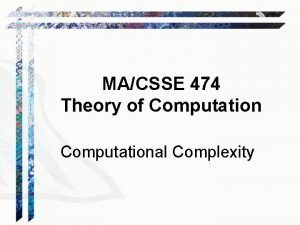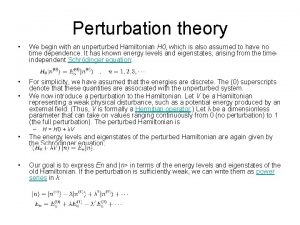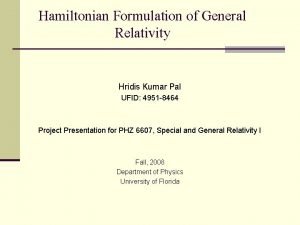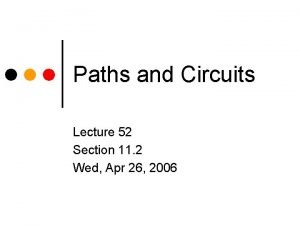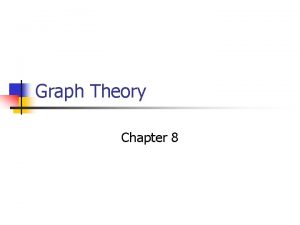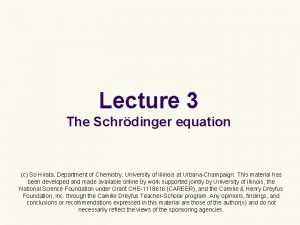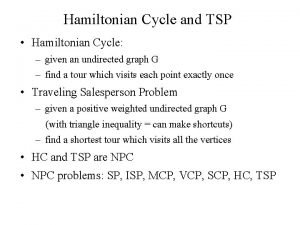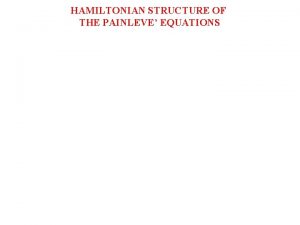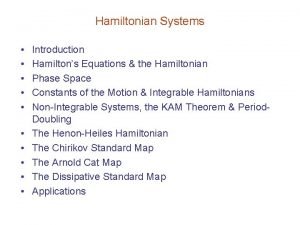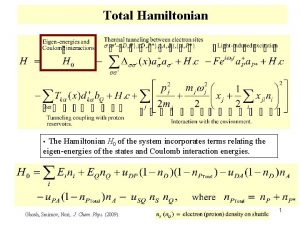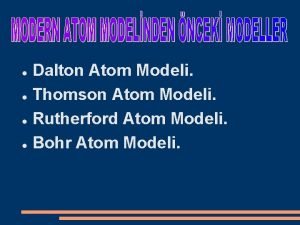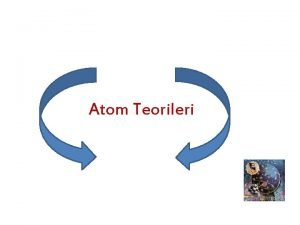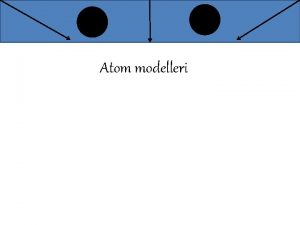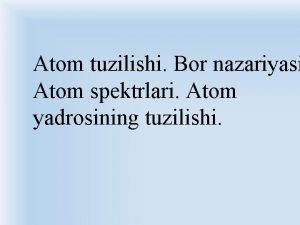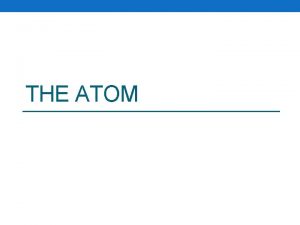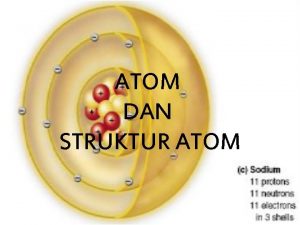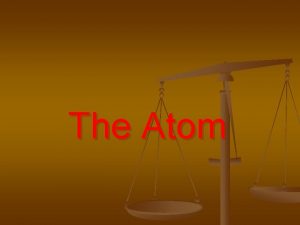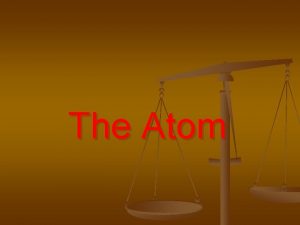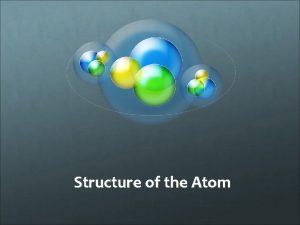H E Hamiltonian for the H atom H






























































































































- Slides: 126

Hψ = E ψ Hamiltonian for the H atom

Hψ = E ψ H = H 1 + H 2 Separated H atoms

H = H 1 + H 2 + H 12 extra term due to interaction as the atoms get close

LCAO-MO Approximation Linear Combination of Atomic Orbitals – Molecular Orbital Approximation

LCAO-MO Approximation Ψ = Σ i c i φi

LCAO-MO Approximation Ψ = Σ i c i φi Ψ molecular wavefunction

In this simple case: Ψ = c 1 φ1 + c 2 φ2

LCAO-MO Approximation Ψ = Σ i c i φi Ψ Σi molecular wavefunction summation operator

LCAO-MO Approximation Ψ = Σ i c i φi Ψ molecular wavefunction Σi summation operator ci orbital coefficient

LCAO-MO Approximation Ψ = Σ i c i φi Ψ molecular wavefunction Σi summation operator ci orbital coefficient φi atomic orbital

1 a T+V→H

1 a T+V→H V = -1/ra 1

a Distance apart ra 1 Coulomb potential V = -eae 1/ra 1 V = -1/ra 1 1

1 a T+V→H V = -1/ra 1 Setting charge e 2 = 1

1 a T+V→H V = -1/ra 1 Setting charge e 2 = 1 Coulombic Potential

1 NOTE The negative sign as energy lowered a T+V→H V = - 1/ra 1 Setting charge e 2 = 1 Coulombic Potential

1 2 a b T+V→H V = -1/ra 1 - 1/rb 2

1 a 2 b V = -1/ra 1 - 1/rb 2

1 a 2 b V = -1/ra 1 - 1/rb 2 + 1/rab

1 a 2 b V = -1/ra 1 - 1/rb 2 + 1/rab + 1/r 12

1 2 a b V = -1/ra 1 - 1/rb 2 + 1/rab + 1/r 12 - 1/ra 2

1 a 2 b V = -1/ra 1 - 1/rb 2 + 1/rab + 1/r 12 - 1/ra 2 - 1/rb 1

H = H 1 + H 2 + H 12 Hψ = E ψ Ψ = c 1 φ1 + c 2 φ2 LCAO MO Approximation Linear Combination of Atomic Orbitals

Electron Density is given by Ψ 2 or Ψ*Ψ




c 1 2 = c 2 2

c 1 2 = c 2 2 c 1 = ±? c 2

c 1 2 = c 2 2 c 1 = ±c 2



Electron Wavefunction Ψ

Electron Wavefunction Ψ

Bonding Orbital Electron Density Ψ 2

Antibonding Orbital Electron Density Ψ 2

H = H 1 + H 2 + H 12

H = H 1 + H 2 + H 12



1 sa + 1 sb + σbonding σ + - 1 sa - 1 sb σantibonding σ*

+ + - The + and – signs are not charge signs they are phase indicators

+ - + Protons pulled towards each other by the buildup of –ve charge in the centre

+ + - + + Protons pulled towards each other by the buildup of –ve charge in the centre Protons repelled as little negative charge build up in the centre

+ + - + + Protons pulled towards each other by the buildup of –ve charge in the centre Protons repelled as little negative charge build up in the centre Note - Now we are discussing the charges

Separate atoms ↑ ↑

At the bond separation the bonding and antibonding orbitals split apart in energy ↑ ↑

The electrons pair up in the lower level – energy is gained - relative to the separate atoms and a stable molecule is formed σ* ↑ ↑ σ ↓↑


E = α - β ↓↑ E=α+β Note β the stabilisation energy is –ve






A contour map of the electron density distribution (or the molecular charge distribution) for H 2 in a plane containing the nuclei.






Fig. 6 -2. A contour map of the electron density distribution (or the molecular charge distribution) for H 2 in a plane containing the nuclei. Also shown is a profile of the density distribution along the internuclear axis. The internuclear separation is 1. 4 au. The values of the contours increase in magnitude from the outermost one inwards towards the nuclei. The values of the contours in this and all succeeding diagrams are given in au; 1 au = e/ao 3 = 6. 749 e/Å3.





Hydrogen. The two electrons in the hydrogen molecule may both be accommodated in the 1 sg orbital if their spins are paired and the molecular orbital configuration for H 2 is 1 sg 2. Since the 1 sg orbital is the only occupied orbital in the ground state of H 2, the density distribution shown previously in Fig. 62 for H 2 is also the density distribution for the 1 sg orbital when occupied by two electrons. The remarks made previously regarding the binding of the nuclei in H 2 by the molecular charge distribution apply directly to the properties of the 1 sg charge density. Because it concentrates charge in the binding region and exerts an attractive force on the nuclei the 1 sg orbital is classified as a bonding orbital. http: //www. chemistry. mcmaster. ca/esam/Chapter_3/section_2. html

Hydrogen. II Excited electronic configurations for molecules may be described and predicted with the same ease within the framework of molecular orbital theory as are the excited configurations of atoms in the corresponding atomic orbital theory. For example, an electron in H 2 may be excited to any of the vacant orbitals of higher energy indicated in the energy level diagram. The excited molecule may return to its ground configuration with the emission of a photon. The energy of the photon will be given approximately by the difference in the energies of the excited orbital and the 1 sg ground state orbital. Thus molecules as well as atoms will exhibit a line spectrum. The electronic line spectrum obtained from a molecule is, however, complicated by the appearance of many accompanying side bands. These have their origin in changes in the vibrational energy of the molecule which accompany the change in electronic energy.




Electron Density Ψ*Ψ








http: //tannerm. com/diatomic. htm





The nucleus is the very dense region consisting of nucleons (protons and neutrons) at the center of an atom. Almost all of the mass in an atom is made up from the protons and neutrons in the nucleus, with a very small contribution from the orbiting electrons. The diameter of the nucleus is in the range of 1. 6 fm (1. 6 × 10− 15 m) (for a proton in light hydrogen) to about 15 fm (for the heaviest atoms, such as uranium). These dimensions are much smaller than the diameter of the atom itself, by a factor of about 23, 000 (uranium) to about 145, 000 (hydrogen). The branch of physics concerned with studying and understanding the atomic nucleus, including its composition and the forces which bind it together, is called nuclear physics.











1 2 a b T+V→H V = -1/ra 1 - 1/rb 2 H 12 = 1/rab + 1/r 12 - 1/ra 2 + 1/rb 1 Setting charge e 2 = 1











The wave function is usually represented by ψ

2 The electron density is given by ψ

probability = ψ2 Electron Density Radius r









- jpg - classweb. gmu. edu/. . . /graphics/H 2 -orbitals. jpg Image may be subject to copyright.








 Hamiltonian operator
Hamiltonian operator Legendre transformation hamiltonian
Legendre transformation hamiltonian Sorted edges algorithm
Sorted edges algorithm Ignorable coordinates
Ignorable coordinates Hamiltonian operator
Hamiltonian operator Lagrangian
Lagrangian Brute force algorithm hamiltonian circuit
Brute force algorithm hamiltonian circuit Particle on a ring
Particle on a ring Grafuri orientate si neorientate
Grafuri orientate si neorientate The hamiltonian operator is given by
The hamiltonian operator is given by Hamiltonian circuit example
Hamiltonian circuit example Shadow hamiltonian
Shadow hamiltonian Javier junquera
Javier junquera Hamiltonian circuit
Hamiltonian circuit Chromatic number
Chromatic number Hamiltonian operator
Hamiltonian operator Hamiltonian circuit
Hamiltonian circuit Unperturbed hamiltonian
Unperturbed hamiltonian Hridis kumar pal
Hridis kumar pal Hamiltonian circuit
Hamiltonian circuit Hamilton's equations of motion
Hamilton's equations of motion Vertex set
Vertex set Schrodinger wave equation
Schrodinger wave equation The structure of the atom section 2 defining the atom
The structure of the atom section 2 defining the atom Teori atom dalton thomson rutherford bohr
Teori atom dalton thomson rutherford bohr Publik sektor
Publik sektor Jiddisch
Jiddisch Etik och ledarskap etisk kod för chefer
Etik och ledarskap etisk kod för chefer Datorkunskap för nybörjare
Datorkunskap för nybörjare Kvinnlig mantel i antikens rom
Kvinnlig mantel i antikens rom Humanitr
Humanitr Steg för steg rita
Steg för steg rita Fspos
Fspos Ministerstyre för och nackdelar
Ministerstyre för och nackdelar Sju principer för tillitsbaserad styrning
Sju principer för tillitsbaserad styrning Geometri för barn
Geometri för barn Bästa kameran för astrofoto
Bästa kameran för astrofoto Dikt form
Dikt form Nyckelkompetenser för livslångt lärande
Nyckelkompetenser för livslångt lärande Varför kallas perioden 1918-1939 för mellankrigstiden
Varför kallas perioden 1918-1939 för mellankrigstiden Tidbok för yrkesförare
Tidbok för yrkesförare Mästare lärling modell
Mästare lärling modell Orubbliga rättigheter
Orubbliga rättigheter Jätte råtta
Jätte råtta Verktyg för automatisering av utbetalningar
Verktyg för automatisering av utbetalningar Jag har nigit för nymånens skära
Jag har nigit för nymånens skära Plats för toran ark
Plats för toran ark Kolposkopi, px
Kolposkopi, px Stig kerman
Stig kerman Strategi för svensk viltförvaltning
Strategi för svensk viltförvaltning Ro i rom pax
Ro i rom pax Ledningssystem för verksamhetsinformation
Ledningssystem för verksamhetsinformation Typiska novell drag
Typiska novell drag Tack för att ni har lyssnat
Tack för att ni har lyssnat Matematisk modellering eksempel
Matematisk modellering eksempel Centrum för kunskap och säkerhet
Centrum för kunskap och säkerhet Läkarutlåtande för livränta
Läkarutlåtande för livränta Shivaiter
Shivaiter Inköpsprocessen steg för steg
Inköpsprocessen steg för steg Påbyggnader för flakfordon
Påbyggnader för flakfordon Egg för emanuel
Egg för emanuel Anatomi organ reproduksi
Anatomi organ reproduksi Variansen formel
Variansen formel Rutin för avvikelsehantering
Rutin för avvikelsehantering Presentera för publik crossboss
Presentera för publik crossboss Klassificeringsstruktur för kommunala verksamheter
Klassificeringsstruktur för kommunala verksamheter Myndigheten för delaktighet
Myndigheten för delaktighet Tack för att ni lyssnade
Tack för att ni lyssnade Mall debattartikel
Mall debattartikel En lathund för arbete med kontinuitetshantering
En lathund för arbete med kontinuitetshantering Tobinskatten för och nackdelar
Tobinskatten för och nackdelar Nationell inriktning för artificiell intelligens
Nationell inriktning för artificiell intelligens Hur ser ett referat ut
Hur ser ett referat ut Tack för att ni har lyssnat
Tack för att ni har lyssnat Programskede byggprocessen
Programskede byggprocessen Karttecken färger
Karttecken färger Meios steg för steg
Meios steg för steg Rbk mätning
Rbk mätning Kraft per area
Kraft per area Elektronik för barn
Elektronik för barn Kung dog 1611
Kung dog 1611 Förklara densitet för barn
Förklara densitet för barn Tack för att ni har lyssnat
Tack för att ni har lyssnat Smärtskolan kunskap för livet
Smärtskolan kunskap för livet Trög för kemist
Trög för kemist Luftstrupen för medicinare
Luftstrupen för medicinare Vilka tal pekar pilarna på
Vilka tal pekar pilarna på Delegerande ledarskap
Delegerande ledarskap Returpilarna
Returpilarna Underlag för särskild löneskatt på pensionskostnader
Underlag för särskild löneskatt på pensionskostnader Blomman för dagen drog
Blomman för dagen drog Redogör för vad psykologi är
Redogör för vad psykologi är Borra hål för knoppar
Borra hål för knoppar Bris för vuxna
Bris för vuxna Mat för unga idrottare
Mat för unga idrottare Tư thế ngồi viết
Tư thế ngồi viết Bàn tay mà dây bẩn
Bàn tay mà dây bẩn Mật thư anh em như thể tay chân
Mật thư anh em như thể tay chân Các châu lục và đại dương trên thế giới
Các châu lục và đại dương trên thế giới Bổ thể
Bổ thể Tư thế ngồi viết
Tư thế ngồi viết Thế nào là giọng cùng tên?
Thế nào là giọng cùng tên? Thẻ vin
Thẻ vin Thơ thất ngôn tứ tuyệt đường luật
Thơ thất ngôn tứ tuyệt đường luật Hát lên người ơi alleluia
Hát lên người ơi alleluia Hổ sinh sản vào mùa nào
Hổ sinh sản vào mùa nào Từ ngữ thể hiện lòng nhân hậu
Từ ngữ thể hiện lòng nhân hậu Diễn thế sinh thái là
Diễn thế sinh thái là Vẽ hình chiếu vuông góc của vật thể sau
Vẽ hình chiếu vuông góc của vật thể sau 101012 bằng
101012 bằng Tỉ lệ cơ thể trẻ em
Tỉ lệ cơ thể trẻ em Lời thề hippocrates
Lời thề hippocrates đại từ thay thế
đại từ thay thế Vẽ hình chiếu đứng bằng cạnh của vật thể
Vẽ hình chiếu đứng bằng cạnh của vật thể Quá trình desamine hóa có thể tạo ra
Quá trình desamine hóa có thể tạo ra Môn thể thao bắt đầu bằng từ chạy
Môn thể thao bắt đầu bằng từ chạy Công thức tính thế năng
Công thức tính thế năng Thế nào là mạng điện lắp đặt kiểu nổi
Thế nào là mạng điện lắp đặt kiểu nổi Hình ảnh bộ gõ cơ thể búng tay
Hình ảnh bộ gõ cơ thể búng tay Khi nào hổ con có thể sống độc lập
Khi nào hổ con có thể sống độc lập Các loại đột biến cấu trúc nhiễm sắc thể
Các loại đột biến cấu trúc nhiễm sắc thể Biện pháp chống mỏi cơ
Biện pháp chống mỏi cơ độ dài liên kết
độ dài liên kết Gấu đi như thế nào
Gấu đi như thế nào Thiếu nhi thế giới liên hoan
Thiếu nhi thế giới liên hoan điện thế nghỉ
điện thế nghỉ Một số thể thơ truyền thống
Một số thể thơ truyền thống
